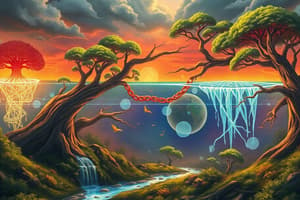Podcast
Questions and Answers
Producers are at the second trophic level in a food chain.
Producers are at the second trophic level in a food chain.
False (B)
Only about 10% of the energy is transferred from one trophic level to the next in a food chain.
Only about 10% of the energy is transferred from one trophic level to the next in a food chain.
True (A)
Decomposers are organisms that primarily consume plants.
Decomposers are organisms that primarily consume plants.
False (B)
A food web is a simple linear sequence of organisms.
A food web is a simple linear sequence of organisms.
Carnivores can only be found at the first trophic level.
Carnivores can only be found at the first trophic level.
Herbivores are classified as primary consumers in a food chain.
Herbivores are classified as primary consumers in a food chain.
Disruption in one part of a food chain can affect the entire ecosystem.
Disruption in one part of a food chain can affect the entire ecosystem.
Omnivores only consume either plants or animals, but not both.
Omnivores only consume either plants or animals, but not both.
Energy flows from higher trophic levels to lower trophic levels in a food chain.
Energy flows from higher trophic levels to lower trophic levels in a food chain.
Pollution can disrupt food chains by affecting biodiversity.
Pollution can disrupt food chains by affecting biodiversity.
Flashcards
Food Chain
Food Chain
A linear sequence of organisms where each organism feeds on the one below, showing energy flow.
Trophic Level
Trophic Level
An organism's position in a food chain, based on its energy source.
Producer
Producer
An organism that makes its own food, usually through photosynthesis.
Consumer
Consumer
Signup and view all the flashcards
Primary Consumer
Primary Consumer
Signup and view all the flashcards
Secondary Consumer
Secondary Consumer
Signup and view all the flashcards
Decomposer
Decomposer
Signup and view all the flashcards
Energy Flow
Energy Flow
Signup and view all the flashcards
Food Web
Food Web
Signup and view all the flashcards
Ecosystem Balance
Ecosystem Balance
Signup and view all the flashcards
Study Notes
Defining Food Chains
- A food chain is a linear sequence of organisms where each organism feeds on the one below it.
- It depicts the flow of energy and nutrients through an ecosystem.
- The chain begins with a producer (e.g., a plant).
- Subsequent links are consumers (e.g., herbivores, carnivores, omnivores).
- The chain culminates in a decomposer (e.g., fungi, bacteria).
Trophic Levels
- Trophic levels represent the position of an organism in the food chain.
- Producers are at the first trophic level.
- Herbivores (primary consumers) are at the second trophic level.
- Carnivores (secondary, tertiary, or higher-level consumers) consume other animals.
- Decomposers break down dead organisms and return nutrients to the ecosystem.
Components of a Food Chain
- Producers: Autotrophs that produce their own food (e.g., plants, algae).
- Consumers: Heterotrophs that consume other organisms for energy.
- Primary consumers: Herbivores that eat plants.
- Secondary consumers: Carnivores that eat herbivores.
- Tertiary consumers: Carnivores that eat other carnivores.
- Omnivores: Organisms that consume both plants and animals.
- Decomposers: Organisms (bacteria, fungi) that break down dead organisms and return nutrients to the soil.
Energy Flow in Food Chains
- Energy flows from one trophic level to the next.
- With each transfer, a significant portion of energy is lost as heat.
- Only about 10% of the energy from one trophic level is transferred to the next.
- This limits the length of a typical food chain (usually 4-5 trophic levels).
Food Webs
- Food chains rarely exist in isolation.
- Organisms are often part of multiple food chains.
- A food web represents the complex network of interconnected food chains in an ecosystem.
- A food web illustrates the feeding relationships among different species in a more comprehensive way.
Importance of Food Chains
- Food chains illustrate the interconnectedness of organisms in an ecosystem.
- Understanding food chains is critical for understanding ecosystem balance and stability.
- Disruptions in one part of a food chain can have significant effects throughout the entire system.
Impacts of Human Activity
- Human activities, such as pollution, habitat destruction, and overfishing, can disrupt food chains and harm biodiversity.
- Improper use of pesticides, for example, can harm or eliminate important insects, affecting bird populations in particular and the entire food chain.
- Human actions can lead to imbalances in ecosystems, impacting the abundance and distribution of species.
Studying That Suits You
Use AI to generate personalized quizzes and flashcards to suit your learning preferences.




